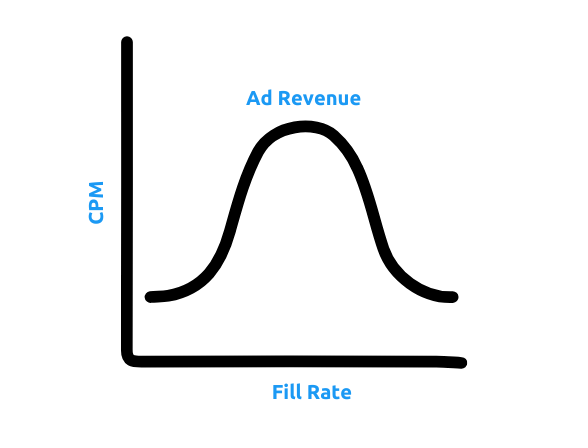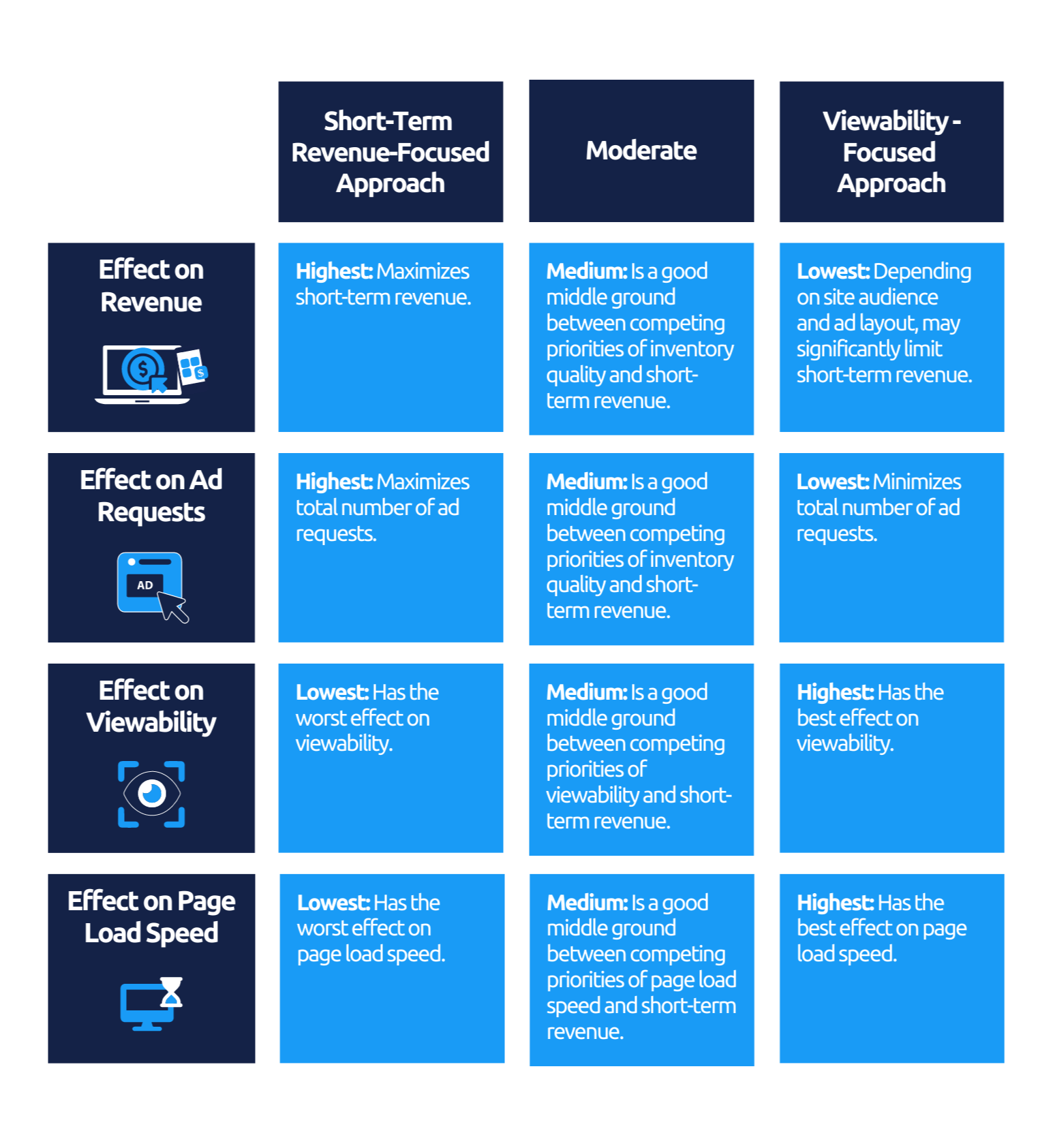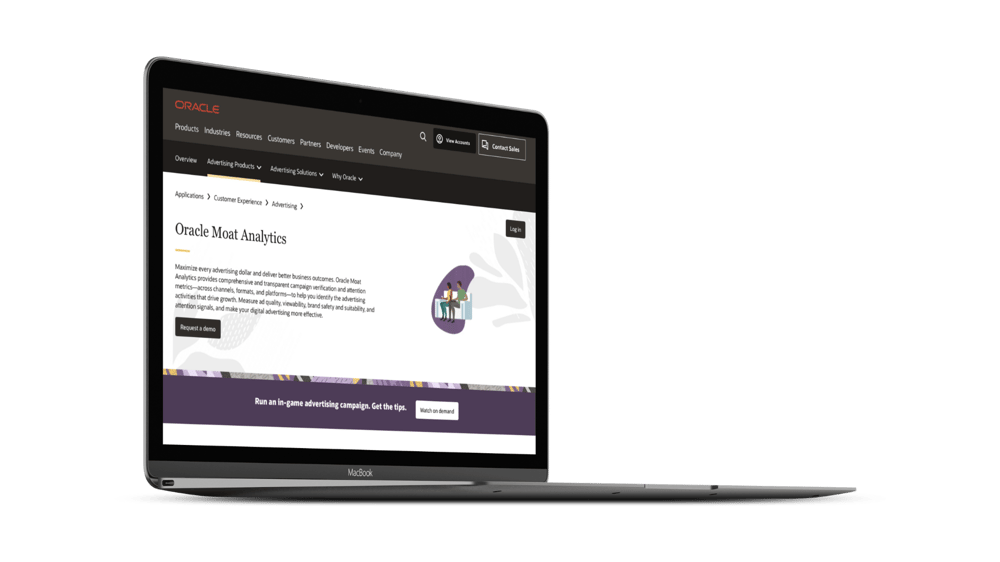The Complete Guide to Ad Viewability For publishers
Get a PDF copy of the guide using the form below, or scroll down to read the entire guide right on this page.
.png)
Don't Have Time To Read the Entire Guide Now?
We'll email you a downloadable PDF version of the guide and you can read later.
All of our content is generated by subject matter experts with years of ad tech experience and structured by writers and educators for ease of use and digestibility. Learn more about our rigorous interview, content production and review process here.
Built with the expertise of:
Introduction
Streamlined and optimized monetization strategy is like a ballet: impeccably choreographed whilst looking completely effortless.
Picture it: all the elements that make your ad revenue dreams possible coming together in perfect synchronicity. High-quality ad units, ideal traffic demographics, and killer engagement rates all pirouetting in perfect unison.
It’s a beautiful sight. But no one will see it if you don’t sell tickets to the show.
That’s where viewability comes in.
You could have great inventory and valuable content, but without eyeballs coming to and staying on your site, it’s all for nothing.
Viewability is a big deal for publishers and advertisers. It’s one of the main ad revenue metrics you should be thinking about as a publisher when evaluating the value of your inventory because it’s absolutely something that advertisers are paying attention to.
And, like most things in the world of ad tech, it’s not easy to master.
Don’t worry: we’ll help you find your footing. Keep reading to learn everything you need to know about viewability.
table of
contents
What is Viewability in Digital Advertising?
Do visitors see the ads placed on your site? This is the question your viewability rating answers.
Viewability is one of the primary metrics by which advertisers gauge the value of your ad inventory. It tracks impressions and grades the ad unit based on how often the ad was actually seen by site visitors.
It makes perfect sense why an advertiser would use viewability as an indicator. An ad that isn’t in view has no chance of ever being clicked on (the advertisers’ ultimate end goal), so viewability is a great leading indicator for the ability to get a click-through.
If visitors see your digital ads more frequently than not, your rating will be high. If they don’t, it will be low.
Here’s an example of what is meant by “viewable” —
If an ad unit is located lower on the page and a user doesn’t scroll far enough to see it, that means it was not viewable during that session.
Viewability is measured in percentages, but that concept breaks down when you talk about a single ad impression. Either an ad is viewable or it isn’t — it can’t be 70% viewable. A viewability rating tracks the likelihood of that ad being viewed.
So a 70% viewability rating means that, historically, an ad was viewable 70% of the time and nonviewable 30% of the time. Because viewability is so heavily dependent on user behavior, there’s no way for advertisers to know if the ad they place there will be in the 70% bucket or the 30% bucket. But the higher the percentage, the better their chances.
That’s why advertisers pay more for ad units with higher viewability ratings.
What is a Viewable Ad?
The Media Rating Council has an established set of viewability guidelines to help advertisers and publishers align on standard practices.
Here they are —
- An ad must be at least 50% visible for a minimum of 1 second
- Display ads larger than 242,500 pixels must be at least 30% visible for a minimum of 1 second
- Video ads must be at least 50% visible for a minimum of 2 seconds
If an impression meets the above criteria, it counts as a view and increases your viewability rating.
Viewability Definitions
There are a few different ways to think about viewability. Here are some terms to know —
- Ad calls/ad requests: Each time a new session begins, a website will send an ad call to an ad exchange to request an ad unit for potential viewing. Depending on your site’s refresh settings, an ad unit may or may not be displayed multiple times within a single visitor’s session.
- Viewable impression: This metric demonstrates the frequency at which your ads were viewable.
- Viewability rate: This percentage summarizes how many of your impressions were viewable.
Why is Viewability Important for Publishers?
Because it’s important to advertisers.
All advertisers have the same end goal: to reach the right audience at the right time with their ads. If your ad isn’t viewable, the chance of securing a click or video completion is zero.
So low viewability means a low chance of delivering positive results for advertisers. Would you buy a ticket to the ballet if there were only a 30% chance you’d be able to see the stage? Advertisers want to feel confident that they’ll get what they pay for. And viewability is a good way to establish that trust.
That’s why viewability is one of the primary metrics you should be reviewing to understand if and where there is the most value for advertisers to show ads on your site. The more viewable ads you have on your site, the higher the likelihood of a positive outcome for advertisers. Better outcomes for publishers mean a better chance quality media buyers and brands will continue to advertise on your site.
Plus, when advertisers crunch the numbers, higher visibility ratings will result in an increase in ad spend on your units.
So high viewability rating = a better fill rate and higher CPMs.
And higher CPMs = more $$$ in your pocket.
The Interplay Between Viewability and Revenue
Although there is an increasing demand for 100% viewability, in general, you shouldn’t think about it in black and white. Ads are rarely 100% or 0% viewable. We recommend novice publishers aim to have an ad viewability rate of between 60% and 70%, but keep in mind your sweet spot for viewability will be highly dependent on the value advertisers place on the makeup of your audience as well.
However, improving ad viewability isn’t a simple process. It’s a strange concept to understand — since they are directly connected — but viewability and revenue can actually be considered opposite forces. Stay with us on this one.
In general, to increase viewability, you need to decrease impressions and requests. Reducing those will ultimately result in less immediate revenue. But it’s important to keep in mind that optimization often means finding a delicate balance between viewability and revenue. This balance is unique to each publisher. Sometimes, you may have to sacrifice viewability to earn revenue and vice versa.
Think of it like an auditorium: the more tickets you sell, the bigger your venue needs to be. But there’s a catch. The bigger the venue is, the less valuable your seats are, since so many of them will have a poor view of the stage.
It’s the same with ad units. The more you have on your page, the less valuable they become. And if you have too many ads, there could be long-term harm to your engagement and user experience, and as a result, your viewability.

You’re looking for the sweet spot where your inventory is both rare enough to command a high per-unit price and you have enough volume of that inventory to maximize revenue.
In general, the tradeoffs look something like this:

How to Improve Ad Viewability
Here are a few things you can experiment with to improve viewability on your site —
- Test out different ad units and ad placements
- Experiment with lazy loading and your refresh settings
- Organize and categorize your highly-viewable inventory
Ultimately, improving your viewability is a challenge, which is why many publishers often feel it’s not always worth the effort. We can promise you it is. We can also promise you that working with a revenue partner, such as Playwire and our team of yield ops experts, can help you discover the sweet spot of viewability optimization.
The Ultimate Impact Ad Viewability Has on Publisher Revenue
.png)
Viewability is a long game. It’s essentially like signing an agreement with advertisers to avoid the short-term money grab of nonviewable inventory in favor of honoring the advertiser’s objectives.
In real-time, it won’t always look revenue-positive, but you should think of it as an investment in future revenue. By making less profit today, you’re ensuring your business is in a healthier place eight months from now.
On the buy side, a good viewability rating helps establish trust in the agreement. Advertisers also use the rating to crunch the numbers to determine how much they should spend on your inventory.
Say a shoe company wants to advertise on your site. Their average sale is $120. If 10% of ads shown on your site result in a click to their website and 10% of those clicks result in a completed transaction, that means 1% of their ads result in a sale. Since 1% of $120 is $1.20, that means the advertiser can afford to bid $1.20 on your ads.
If 0% of the ads on your site are viewable, that means 0% will get clicked and 0% will result in a sale (hint: this means the advertiser can afford to bid $0 on your site –– not good for business).
So it’s safe to say that viewability has a significant impact on publisher revenue.
How to Calculate and Measure Viewability Metrics
There are several tools for calculating and measuring viewability. Moat by Oracle is considered the viewability standard in the industry. And it’s the industry standard for a good reason.
Moat is an analytics suite that helps both the demand-side and server-side measure ad campaign performance. It evaluates viewability and traffic quality, as well as a wide range of other performance metrics, to build confidence in brand safety and trust between advertisers and publishers.

Another measurement tool is Google’s Active View. Active View is native to Google’s ad server and Google Ad Manager — which are industry-standard ad tech platforms.
The viewability tracking capabilities in Active View are sufficient for the needs of most small to mid-sized publishers, and since it’s native to the publisher’s ad server, it’s a reliable way to get good viewability insights.
Most well-optimized tech stacks use both Moat and Active View. To learn more about building out your own ad tech stack, read our complete guide to the ad tech stack.
Everything You Need to Know About Mobile Ad Viewability
Mobile ad viewability is similar to web viewability. Think the ballet and the opera. Really, there are only a few key differences.
.png)
The first difference is the dimensions of each screen. The lack of available real estate for mobile ads poses a unique challenge for viewability. Simply put, there is less room to play with, which means fewer available ad units and a higher risk of accidental clicks or disappointing user experiences.
Also, the nature of mobile use means interactions are different than on the web. On a desktop, users point and click with a mouse, whereas mobile visitors use their fingers or thumb. This leaves more room for error with accidental interactions.
Because of this, publishers need to be more thoughtful and intentional with ad placement on mobile. On a desktop, you can place ads closer to the content. On mobile, it's better to leave more room between ads and content. In an already limited amount of space, this can pose a significant creative challenge.
Viewability FAQs
A few more things you might want to know about ad viewability —
What’s the Difference Between Video Ad Viewability and Display Ad Viewability?
Similar to mobile vs. desktop: there’s not much of a difference here. But since you asked, let’s get into the deets.
We’ve already established that advertisers won’t spend on digital ads that aren’t seen — duh — and video ads follow the same logic.
That being said, there are secondary environment qualifiers with video ads that don’t exist with display ads. This means that while video ad viewability matters the same as display, viewability can vary drastically depending on the environment of the video. Namely: the size of the video player, whether there is video content around the player, or whether the video ad is tied to the publisher’s video content or another ad.
If you want to improve viewability for video ads, focus on optimizing video ad placement and player size first. Every audience is different, so you’ll need to experiment until you find a combination that works for your visitors.
When Should You Optimize for Viewability?
Since publishers often have to sacrifice short-term revenue to improve viewability, it’s important to make sure the juice is worth the squeeze before embarking on the journey.
One thing to note is that viewability is assessed in a relatively human way. When humans look at viewability numbers, they’re not going to care about minute decimal points. They’re more concerned about certain numeric thresholds, usually at intervals of 5 and 10.
So, if an advertiser is executing a brand awareness ad campaign, a human being is going to make a decision based on the numbers. They won’t advise a media buyer to target inventory with a 64.68% viewability rating. They’re more likely to recommend that the media buyer chooses inventory with a rating of 65% or above.
This means publishers don’t often gain a substantial amount of new revenue when optimizing viewability in nonhuman-focused chunks. Optimizing from 66% to 69% won’t make a huge difference. But if your site viewability rate is sitting at 68% and you can get it to a consistent 70%, you’ll see a measurable pop in your RPMs.
It’s best practice to think about optimizing viewability in chunks of between 5% and 10%. Even if it's the same rate of increase, it’s often not worth it to optimize to 63% or 69% but it can be worth it to optimize to a human threshold. The latter is more likely to activate new demand for your business.
Related Content
Feel free to visit our Complete Ad Viewability Resource Center, or dive deeper into any of these related articles:
- Why is Viewability Important for Publishers?
- What is Viewability in Digital Advertising?
- The Impact Ad Viewability Has on Publisher Revenue
- A Guide to Video Ad Viewability
- How to Calculate and Measure Viewability Metrics
- Everything You Need to Know About Mobile Ad Viewability
- Strategies for Improving Ad Viewability
Nail Your Viewability Goals With Playwire
As you’re well aware by now, improving viewability on your own can be a challenge. From minor ad placement tweaks to massive inventory overhauls, the potential risks these changes can have on your revenue mean that the viewability optimization process should not be taken lightly. Never mind the burden of consistent management and the learning curve required to efficiently use measurement tools like Moat.
Playwire is here to support the delicate dance between revenue and viewability. We have the tools and know-how to help you hit your viewability targets so you can activate new demand and reach your revenue goals.
Ready to get started? Reach out to us online today.
Amplify
Your Ad Revenue
Accelerate your business and uncomplicate your ad tech stack, because you deserve a partner and a platform that demands more for you.
